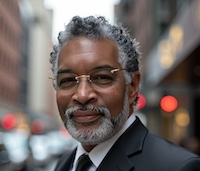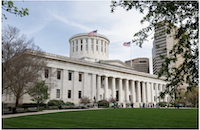Jabaar Edmond has long advocated for better air quality in his Childs Park neighborhood in St. Petersburg, Florida.
For decades, residents of the predominantly black neighborhood complained of a persistent gasoline-like odor.
“We had an initiative called ‘Smell something, say something,’” said Edmond, former president of the neighborhood’s association. Residents have long sounded that alarm, blaming the noxious odor on a nearby oil recycling facility.
Last year, the city funded the planting of more than 180 trees across the neighborhood. Trees help battle the urban heat island effect and filter pollutants, which can mitigate odors and improve air quality. The project was funded by a federal grant from the U.S. Forest Service.
But now, the agency is hindering such efforts, canceling a grant that supports tree-planting in disadvantaged communities.
Communities across the nation are losing federal funds that helped pay for environmental justice efforts designed to mitigate the health effects of pollution and other hazards on historically underserved communities. President Donald Trump’s administration has targeted those initiatives in its drive to eliminate diversity, equity and inclusion — or DEI — programs.
“Where it hurts for us is we still have a huge environmental problem that’s occurring in real time that we’re attempting to mitigate,” Edmond said.
Environmental justice refers to equitable access to healthy environments. Federal housing policies and disinvestment in historically segregated communities have been linked to numerous health consequences. Communities of color have been disproportionately exposed to refineries and other sources of pollution. Air pollution is linked to asthma, cardiovascular problems and lower life expectancy.
Such systematic, disproportionate exposure to industrial pollutants and disinvestment is known as environmental racism. Research shows, for example, that black Americans living in communities that were redlined — a discriminatory practice under which the federal government and banks systematically denied mortgages to residents of minority neighborhoods — have lower life expectancy and more exposure to air pollution and other hazards. Meanwhile, many tribal communities have been the sites of or near mineral mining and oil and gas development.
The Biden administration awarded grants to help correct those harms, centering environmental justice and climate change across multiple federal agencies. The Justice40 initiative aimed to invest 40% of federal climate, housing, clean energy and clean water benefits in historically underserved communities.
Now, Environmental Protection Agency Administrator Lee Zeldin has canceled more than 400 environmental justice grants totaling $1.7 billion.
Democrats are accusing EPA of illegally canceling the grants, as many were funded through Biden-era congressionally appropriated funds under the Inflation Reduction Act. EPA canceled the grants as part of sweeping cuts to what the Trump administration and Elon Musk’s Department of Government Efficiency task force deem unnecessary spending. In recent weeks, Democrats have demanded Zeldin reverse the cancellations.
The Trump administration has also shut down the EPA’s Office of Environmental Justice, as well as the Office of Climate Change and Health Equity.
State environmental and health departments, regulatory agencies, city and county governments, elementary schools, nonprofits and tribal communities were among those that received grants.
The grant-funded projects had a broad range of missions: They included child lead-poisoning prevention efforts, community air monitoring, tree-planting efforts and solar energy investments.
“I don’t know how we’ve come to demonize the idea that people deserve to breathe clean air, drink clean water and have access to environments that are non-polluting,” said Diana Hernandez, associate professor of sociomedical sciences at Columbia University’s Mailman School of Public Health. “It’s a big loss, and it’s destabilizing.”
Hernandez, a former member of New York City’s Environmental Justice Advisory Board, researches health, housing and energy insecurity. Many of her studies focus on communities like the South Bronx, the neighborhood she calls home, where the air is heavy with emissions because multiple highways converge there. Children and adults in the Bronx have higher rates of emergency room visits for asthma than residents of any other New York City borough.
“I grew up in a community of need. It’s officially labeled as an environmental justice community, a disadvantaged community,” she said. “My mom is my next-door neighbor, and so we weekend in the ’hood. We still have our place there.”
The goal of her work has been to elevate the “lived realities of people in communities like the South Bronx.”
“You can’t take care of people if the organizations and agencies that are looking out for their best interests through oversight are gone,” she said.
‘A gut punch’
Many grantees, particularly those associated with universities, are hesitant to speak out about the impact a loss in funds will have on their projects.
“They’re just struggling and trying to figure out, ‘How do we push back in a way that doesn’t put a target on us?’” said Ryan Hathaway, director of environment and climate justice at Lawyers for Good Government.
His organization is leading a pro bono network offering legal advice to hundreds of groups as well as to state and local agencies whose grants are frozen or canceled.
Hathaway previously served under the Biden administration as director for environmental justice and the White House Interagency Council on Environmental Justice.
“It’s still shocking to me to have these interviews,” he said. “We’re talking about whether or not it’s good for children to be able to drink water safely. It just feels like a gut punch.”
Black children, for example, are more likely to have higher average blood lead levels, from exposure to water pumped through lead pipes in older buildings, as well as through lead paint. Lead poisoning can cause irreversible cognitive development damage in children as they rapidly develop.
Among the grants targeted for cancellation was a $500,000 award to the nonprofit Childhood Lead Action Project, as well as a $1 million award to Kansas City, Missouri, for soil lead mitigation. A $14 million grant awarded to Texas A&M University and the Black Belt Unincorporated Wastewater Program aimed to install wastewater treatment systems throughout 17 Alabama counties. In highly documented cases, residents were contracting infections such as hookworm, more commonly associated with developing countries in the global south, amid a lack of proper, expensive septic systems.
There's just so many programs that help neighborhoods be better places to live that states and communities were counting on. – Ryan Hathaway, director of environment and climate justice at Lawyers for Good Government
CleanAIRE NC, which works to address air pollution across North Carolina, was slated to install 40 air monitors across four low-income white, black and Hispanic communities in north Mecklenburg County. But about two weeks ago, the group’s $500,000 grant was terminated. The team had used less than half of the funds, and planned to train “air keepers” to track and monitor air quality.
One of the communities included a historic black neighborhood near old asbestos factories and at the convergence of freeways and industrial complexes, said Executive Director Jeffrey Robbins. Many residents there struggle with asthma and heart disease, he added.
It’s “sad that we’re at this juncture,” Robbins said. “But we’re going to continue to battle and fight for information and the science behind it, and for the communities that are being impacted.”
Dr. Lisa Patel, a Bay Area pediatric hospitalist and executive director of the Medical Society Consortium on Climate and Health, noted that pollution affects babies’ health even before they’re born.
“The children that I worry about the most are the ones that are placed at a disadvantage before they’ve even drawn first breath,” she said. “Fossil fuel pollution crosses the placenta, enters the developing fetus. And so essentially, children are born pre-polluted, and there’s a higher risk of that if you live in these neighborhoods that tend to be systemically divested.”
Patel said that organizations her group’s research has helped are “trying to find ways to ensure that kids can have a healthy start.”
“And that’s the money that’s being taken away,” she said.
Some states have their own environmental justice agencies or laws and have filed motions to challenge the Trump administration’s direction. Others are continuing to lean on their own agency strategies amid the chaos.
The Massachusetts Department of Health, for example, was awarded a $191,000 grant for an asthma control project, another grant targeted for elimination.
In response to an interview request, an official with the state Executive Office of Energy and Environmental Affairs said in a statement that the agency will “continue to invest in communities facing environmental challenges and extreme weather events.”
“We’re dedicated to promoting environmental justice and equity by breaking down barriers and creating economic opportunities for communities hit hard by pollution and climate change,” wrote Maria Belen Power, the office’s undersecretary of environmental justice and equity.
Massachusetts, New Jersey and several other states filed a motion to defend a federal chemical accident safety rule. The attorneys general say the rule is a crucial tool to protect vulnerable communities near chemical manufacturing plants.
Continuing efforts
In 2020, New Jersey enacted a landmark law requiring the state to evaluate environmental and public health impacts of facilities on overburdened communities.
The law mandates permit denials if the facilities cannot avoid disproportionate impacts on the surrounding communities already deemed overburdened by industry. The state also uses an environmental public health and environmental justice tracking tool.
“Our [environmental justice] law and our rules are being appealed before our intermediate appellate court right now. There are some industry players who are concerned that it will scare away business,” Shawn LaTourette, New Jersey’s commissioner of environmental protection, told Stateline.
But LaTourette said the state is not pausing its environmental justice efforts in the meantime.
Meanwhile, Hathaway’s group, Lawyers for Good Government, is hearing from many organizations with unfinished efforts.
“Be it EV charging station infrastructure or improving bus idling in the cities,” Hathaway said. “There’s just so many programs that help neighborhoods be better places to live that states and communities were counting on.”
Abigail Fleming, associate director of the University of Miami’s Environmental Justice Clinic at the School of Law, said many groups the clinic works with have had their federal grants frozen, including grants toward air monitoring in Miami-Dade County and cleaner water.
“There was so much excitement about some of the future of these projects and what they could conquer,” Fleming said.
For Edmond, the St. Petersburg resident, that momentum isn’t over.
“We need to do it with or without the federal dollars,” he said.
• • •• • •
This story is provided by Ohio Capital Journal, a part of States Newsroom, a national 501(c)(3) nonprofit. See the original story here.














